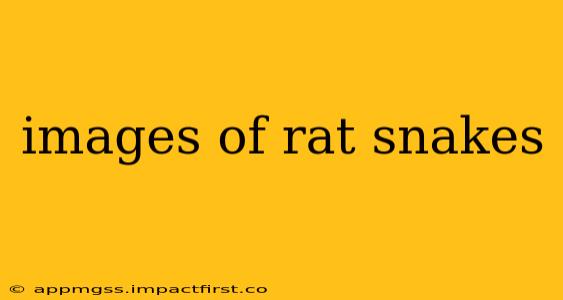Images of Rat Snakes: A Visual Guide to These Majestic Reptiles
Rat snakes are a diverse group of non-venomous colubrid snakes found across the globe. Their captivating patterns and impressive size make them popular subjects for photography and a fascinating group to study. While a simple Google image search will yield thousands of results, this guide will help you understand what makes a rat snake picture truly stand out, and what to look for when identifying these beautiful creatures.
What types of rat snakes are there?
This is a crucial starting point! "Rat snake" is a common name encompassing many different species. Their appearance varies considerably depending on their geographic location and specific species. Some of the most well-known include:
- Eastern Rat Snake (Pantherophis alleghaniensis): Often displaying a gray or brown base color with darker blotches or saddles.
- Corn Snake (Pantherophis guttatus): Known for their beautiful and varied patterns, ranging from reds and oranges to browns and blacks. (While often called a rat snake, it's important to note it's a distinct species).
- Great Plains Rat Snake (Pantherophis emoryi): Typically a more muted gray or brown, often with darker markings.
- Texas Rat Snake (Pantherophis obsoletus lindheimeri): Exhibiting a range of colors and patterns, similar to the Eastern Rat Snake but with regional variations.
Searching for images using the specific species name will yield far more accurate and relevant results.
What are the best features to look for in a photograph of a rat snake?
A truly great image goes beyond simply showing the snake. Here's what makes a picture stand out:
- Sharp focus: A clear, well-focused image allows viewers to appreciate the details of the snake's scales, patterns, and eyes.
- Good lighting: Natural light often works best, highlighting the snake's colors and texture without harsh shadows.
- Composition: Consider the background and how the snake is positioned within the frame. A visually appealing composition can significantly improve the overall impact of the image.
- Natural behavior: Images capturing the snake in its natural environment, perhaps basking in the sun or exploring its surroundings, are often more captivating than posed shots.
- Scale and context: Showing the size of the snake in relation to its environment helps viewers understand its scale and appreciate its presence.
Where can I find high-quality images of rat snakes?
Beyond simple image searches, consider these options:
- Reputable wildlife photography websites: Many professional wildlife photographers specialize in reptiles and amphibians, and their websites often showcase stunning images.
- Nature documentaries and television shows: Many nature programs feature beautiful footage of rat snakes. Check their online archives or social media.
- Scientific publications and research papers: Academic journals often include high-quality images used in research studies.
- Herpetological societies and organizations: These organizations sometimes have image libraries or can direct you to photographers who specialize in reptiles.
Are there any legal considerations when using images of rat snakes?
Always respect copyright laws. If you intend to use an image for anything beyond personal viewing, make sure to obtain permission from the copyright holder or use images licensed for commercial use (Creative Commons licenses, for example). Many online image repositories clearly state their licensing terms.
By understanding these factors, you can find and appreciate the beauty and diversity captured in images of these fascinating reptiles. Remember to always admire rat snakes from a safe distance and respect their natural habitats.
